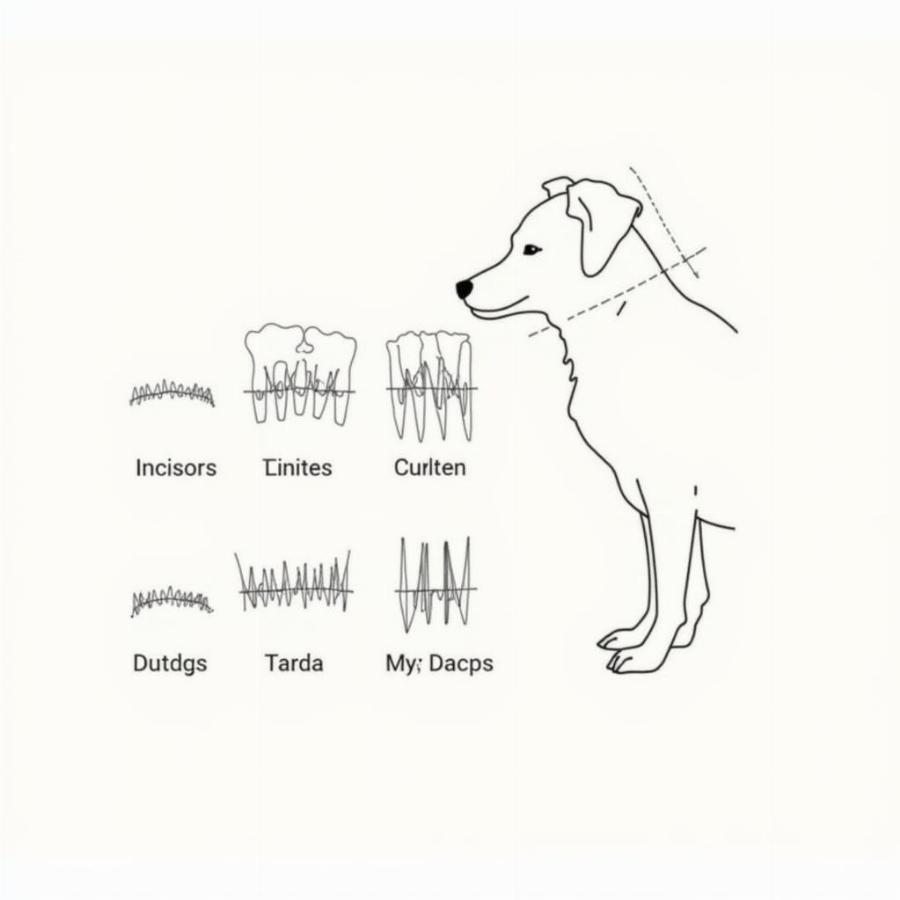As a dog owner, it can be terrifying to discover that your furry friend has broken a tooth. Dogs use their teeth for everything from eating and playing to grooming and defending themselves. So when a tooth gets damaged, it’s a serious matter. Don’t panic! In this article, we’ll guide you through what to do if your dog breaks off part of his tooth, explain potential causes, and discuss treatment options.
Understanding Dog Teeth
Before we dive into the specifics of a broken tooth, it’s helpful to understand the basic anatomy of a dog’s mouth. Dogs have four types of teeth: incisors, canines, premolars, and molars. Each type has a specific function. The large canines are particularly important for grabbing and tearing, while the premolars and molars are designed for chewing and grinding.
 Dog teeth anatomy diagram
Dog teeth anatomy diagram
Why Did My Dog Break His Tooth?
Dogs can break their teeth for a variety of reasons. Some common culprits include:
- Chewing on hard objects: This is the most frequent cause of broken teeth in dogs. Bones, rocks, hard plastic toys, and even ice cubes can be too tough for even the strongest teeth.
- Trauma or Injury: A fall, fight with another animal, or getting hit by a car can all result in dental trauma.
- Dental Disease: Periodontal disease weakens teeth, making them more susceptible to breakage.
Signs Your Dog May Have Broken a Tooth
Sometimes, a broken tooth is obvious. You may even find the broken piece on the floor! However, some fractures are subtle. Here are some signs to watch for:
- Pawing at the mouth: Your dog may paw at his mouth or rub his face against objects if he is experiencing pain.
- Drooling excessively: Increased drooling can indicate oral discomfort.
- Bleeding from the mouth: While not always present, blood in your dog’s saliva can be a sign of a broken tooth.
- Difficulty eating or chewing: If your dog is hesitant to eat, favors one side of his mouth, or drops food, it could signal a dental problem.
- Swelling or redness around the gums: Inflammation around the gum line may indicate a tooth root abscess.
What To Do If You Suspect a Broken Tooth
If you notice any of the above signs or suspect your dog has broken a tooth, it’s crucial to contact your veterinarian immediately. Do not delay! Prompt treatment can help prevent infection, alleviate pain, and save the tooth.
How Are Broken Dog Teeth Treated?
The appropriate treatment for a broken tooth will depend on several factors, including the severity of the break, the location of the fracture, and the overall health of your dog. Your veterinarian will likely take dental X-rays to assess the extent of the damage.
Here are some common treatment options:
- Tooth Extraction: If the tooth is severely fractured or infected, extraction may be the best course of action.
- Root Canal: For fractures that extend into the pulp cavity (the tooth’s inner core), a root canal may be necessary to save the tooth.
- Dental Filling or Crown: Minor fractures may be repaired with a filling or crown, similar to procedures done in human dentistry.
Preventing Future Dental Problems
While accidents can happen, there are steps you can take to minimize the risk of your dog breaking a tooth:
- Choose appropriate chew toys: Avoid hard toys like bones, antlers, and hard plastic. Opt for softer toys made from rubber or nylon designed for chewing.
- Provide regular dental care: Brush your dog’s teeth daily or at least several times a week.
- Schedule professional dental cleanings: Your veterinarian can perform thorough dental cleanings and check for any signs of dental disease.
- Feed a balanced diet: A nutritious diet contributes to good overall health, including dental health.
Can I Ignore a Broken Dog Tooth?
It might be tempting to “wait and see” if a broken tooth will heal on its own. However, ignoring a broken tooth can lead to serious complications, such as:
- Pain and discomfort: Even a small fracture can be painful for your dog.
- Infection: A broken tooth can create an entry point for bacteria to enter the bloodstream, leading to infection.
- Loss of the tooth: Without treatment, a broken tooth may need to be extracted.
- Jaw problems: A broken tooth can affect your dog’s bite, potentially leading to jaw pain and difficulty eating.
Don’t Wait, Seek Veterinary Attention
A broken tooth is a painful experience for your furry friend. Early intervention offers the best chance of saving the tooth and preventing complications. If you suspect your dog has a broken tooth, contact your veterinarian right away for a comprehensive dental examination and treatment plan.
Frequently Asked Questions About Broken Dog Teeth
Q: Can a dog’s tooth heal on its own?
A: Unfortunately, no. Unlike bones, teeth have a limited ability to heal, especially fractures.
Q: How much does it cost to fix a broken dog tooth?
A: The cost of treatment varies depending on the severity of the break, the treatment required, and your location. Your veterinarian can provide an estimate.
Q: Can I use human toothpaste on my dog?
A: No! Human toothpaste often contains xylitol, a sweetener that is toxic to dogs. Always use toothpaste formulated for dogs.
Q: Are certain dog breeds prone to broken teeth?
A: Yes, smaller breeds and those with flatter faces, such as Chihuahuas and Pugs, are more susceptible to dental problems, including broken teeth.
Need More Help?
If you have any further questions or concerns about your dog’s dental health, please don’t hesitate to contact us at [email protected].
Beaut Dogs is your trusted source for comprehensive information on all things dog-related. From breed guides and training tips to health advice and product reviews, we’re here to help you provide the best possible care for your canine companion. Visit our website at https://beautdogs.com for more helpful articles and resources.